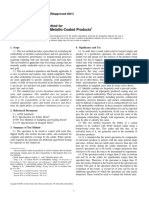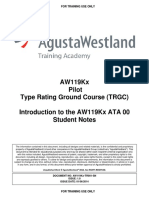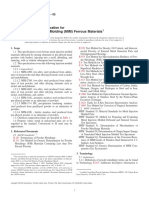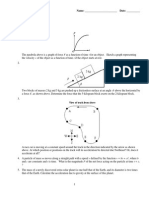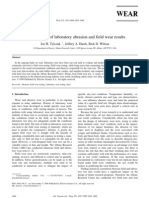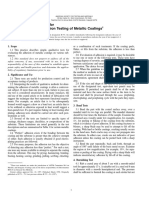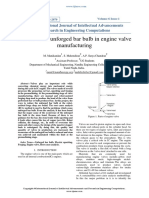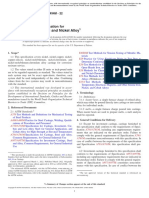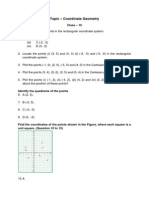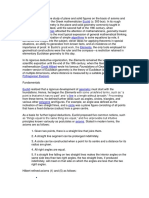Principles of Almen Strip Selection: Academic Study
Principles of Almen Strip Selection: Academic Study
Uploaded by
Umit AytarCopyright:
Available Formats
Principles of Almen Strip Selection: Academic Study
Principles of Almen Strip Selection: Academic Study
Uploaded by
Umit AytarOriginal Description:
Original Title
Copyright
Available Formats
Share this document
Did you find this document useful?
Is this content inappropriate?
Copyright:
Available Formats
Principles of Almen Strip Selection: Academic Study
Principles of Almen Strip Selection: Academic Study
Uploaded by
Umit AytarCopyright:
Available Formats
academic study
Prof. Dr. David Kirk | Coventry University, U.K.
Principles of Almen Strip Selection
INTRODUCTION of A strips, (2) that the sensitivity of A strips is 3.5 times that
The guiding principles for Almen strip selection are thickness, of C strips (3) recommended limits for the use of A strips and
variability and shape. Thickness selection, N, A or C is a (4) a lower limit zone from 0.10mm downwards where there
normally matter for users rather than shot peeners. is an increasing lack of measurement precision.
Thickness is the most important factor, because it is
directly connected to the users’ peening intensity requirement.
As a general rule, the greater the required peening intensity
the thicker will be the most appropriate Almen strip.
Every Almen strip has some variability – in spite of having
to meet specification requirements. The tighter the specifica-
tion the greater will be the cost incurred in satisfying those
requirements. It follows that critical components (for which
shot peening generates a large added value) will justify the use
of higher quality Almen strips than non-critical components.
Almen strips are normally rectangular and are available
in both standard size and as ‘mini-strips’. Circular ‘strips’
are also available for the continuous generation of peening
intensity curves.
This article aims to show why proper selection of
thickness, variability and shape of Almen strips are important
factors in satisfactory shot peening. There are a very large
number of ’in-house’ specifications for Almen strips as well
as the familiar SAE specifications J442 and J443. To avoid
unnecessary complexity, the article is based on the SAE spec-
ifications.
Fig.1 Almen strip sensitivities and recommended
THICKNESS ranges of application.
SAE J442 specifies three standard thicknesses of Almen strips
– designated as N, A and C. The corresponding allowed The majority of shot peening is carried
thickness ranges are 0.76/0.81, 1.27/1.32 and 2.36/2.41 mm out with Almen A strips being involved.
respectively. All three have the same major dimensional They are, however, the only ones that
ranges of 75.6/76.6 mm length and 18.85/19.05 mm width. have specified upper and lower peening
The approximate relationships between peening intensity arc intensity limits. These recommended
heights are that: limits are illustrated in fig.1 and in fig.2.
C strip reading x 3.5 = A strip reading and An important question is:
Why are upper and lower limits
A strip reading x 3.0 = N strip reading.
recommended for Almen A strips?
SAE J443 recommends that A strips be used for peening
intensities from 0.10 mm to 0.60 mm. For intensities Specified Lower Limit when using
below 0.10 mm N strips are recommended and C strips for Almen A strips
intensities above 0.60 mm. These recommendations are A recommended lower limit of 0.10mm
simplistic because (a) they do not allow for overlapping is specified because it has been judged
specified intensity ranges, (b) no lower or upper limits for N
strips are recommended and (c) no upper limit for C strips is
recommended. The overall situation is summarized in fig.1. Fig.2 Recommended Peening Intensity
This indicates (1) that the sensitivity of N strips is 3 times that Limits for Almen A Strips.
24 The Shot Peener | Winter 2013
academic study Continued
that any value below 0.10mm cannot be measured with thickness. Applying this ratio to N strips shows that the upper
sufficient precision. This is logical if we compare measure- limit should be 0.39mm (0.785 x 0.5). The lower limit should
ments less than 0.10mm with the specified Almen gage be the same as for A strips – 0.10mm - applying the same
precision of 0.001mm. For example, a reading measurement of argument about acceptable precision of measurement.
0.050mm reflects an actual strip deflection anywhere between
0.0495mm and 0.0505mm – for which the instrument would Upper and Lower Limits when using Almen C strips
have to round to 0.050mm. With this example there is a ± 1% Applying the ‘half of strip thickness’ concept to C strips would
inaccuracy range. If, for the same shot stream, the thinner N indicate that an upper limit of 1.20mm would be reasonable.
strip was being used then the gage would now read 0.150mm The lower limit could be the same as for N and A strips –
rather than 0.050mm (deflections being some three times 0.10mm - applying the same argument about acceptable
greater). Instead of a ± 1% inaccuracy range we now have ± precision of measurement.
⅓% accuracy.
Specified Peening Intensity Ranges
Specified Upper Limit when using Almen A strips Users specify an allowed range for their required peening
The specified recommended upper limit when using A strips intensity as well as specifying the thickness of strip that has
is an intensity of 0.60mm. This compares with the strips’ to be used (N, A or C). Any specified range may, however,
thickness of 1.295mm. Hence the ratio of allowed peening span over a ‘recommended limit’ e.g. 0.50 to 0.70mm using
intensity to strip thickness is approximately 0.5. This limiting A strips. This is not a problem because it is recognized
ratio can, and probably should, be applied to the other that measurements do not suddenly become invalid if they
thicknesses of Almen strips. exceed a recommended limit. To allow a limited amount of
Shot peening produces a surface layer of plastically- overlapping is perfectly logical. Fig.1 includes a represen-
deformed, compressively-stressed, material. The depth of tation of reasonable amounts of overlapping - based on the
this layer increases with peening intensity. Increased peening previous arguments (gage precision and depth of deformed
intensity is generated by using a combination of increased layer induced by peening). Users could use the mid-point
shot diameter and shot velocity. If the depth of the deformed of their required intensity range as a guide. For example the
layer becomes too high a proportion of the strip thickness mid-point of a 0.50 to 0.70mm range when using A strips
then strip deflection decreases. For the extreme example of is 0.60. This does not exceed the recommended limit of
using flat-ended needles it has been found that strip deflection 0.60mm, so that A strips should be specified. On the other
becomes negative! The theoretical reasons for this behavior hand a range of 0.08 to 1.10mm using A strips would have a
have been given in previous articles in this series. mid-point of 0.95mm so that N strip usage should therefore
Fig.3 is a schematic representation of observed findings be specified (with the three-fold correction) to become 0.24
for A strips. There is a linear response in terms of measured to 0.33mm using N strips.
peening intensity against ‘true’ peening intensity from A to B.
This is the ‘working range’ for A strips. Beyond point B there Effect of Strip Thickness on Gage Reading
is an increasingly-rapid deviation from linearity. Conventional Almen gage dials have a measuring tip that
necessarily contacts the unpeened strip surface with some
degree of force. This force is reported to vary between from
about 50g up to 300g - depending on the manufacturer and
the indicator mechanism involved. The force is a combination
of an internal spring’s force and the elastic resistance of any
protective bellows surrounding the indicator’s stem. Almen
strips held on an Almen gage are therefore subjected to a tip
force and must therefore bend – even if they have not been
peened. Deflection of Almen strips under load has been the
subject of detailed analysis in a previous article (TSP Fall
2009). The appropriate text-book, universally-recognized,
bending of beams equation is that:
Fig.3 Schematic representation of measured peening intensity h = F*s3/(48*E*I) (1)
varying with ‘true’ peening intensity.
where h = maximum deflection at the center of the beam, F =
Upper and Lower Limits when using Almen N strips force applied to the center of the beam, s = distance between
It was pointed out previously that the recommended peening support points, E = Elastic modulus of the beam and I =
intensity upper limit for A strips was half of the strip Second moment of area of the beam (equal to w*t3/12 for
26 The Shot Peener | Winter 2013
academic Study Continued
rectangular beams when w is width and t is the thickness). Force meters are generally very sophisticated (and therefore
Equation (1) assumes that the beam is supported on expensive) but at least one simple but effective instrument is
rollers whereas an Almen gage uses four support balls. available for less than $20. Fig.5 illustrates that instrument
Some additional transverse deflection is therefore generated. together with a typical analogue dial gage. ‘UHU White Tack’
This additional deflection is one-eighth of the longitudinal was used to secure the push/pull spring balance to a heavy
deflection (assuming no anisotropy of elastic modulus). block whilst the dial gage was clamped.
Equation (2) incorporates the additional transverse deflection.
h = 1.125*F*s3/(48*E*I) (2)
The units for the force, F, are Newtons (N). A mass of 1kg
will normally exert a force of 9.81 Newtons (the 9.81 being
the numerical value of the standard acceleration due to
gravity). Hence a mass of 1g will exert a force of 9.81 x 10-3N.
Substituting E = 200kNmm-2, s = 31.75mm and w = 18.95mm
into equation (2) gives the following relationship between
strip deflection, h (in mm), tip force, T (in grams) and strip
thickness, t (in mm):
h(in mm) = T*9.81*10-3 *31.753*12/(48*200*103*18.95*t3 (3)
which simplifies to: Fig.5. Push/pull spring balance testing resistance force of an
analogue dial gage tip.
h(in mm) = T*2.071*10 /t -5 3
(4)
Fig.6 shows the same push/pull spring balance being
Equation (4) can be used to plot the variation of strip applied to a standard EI Almen gage – placed in a horizontal
deflection caused by a range of gage tip forces. This has been position for ease of measurement. The arrangement allows
done in fig.4 where the average thicknesses of Almen strips the ‘force meter’ to be ‘inched’ towards the dial gage (or
have been substituted. should that read “micrometered”!).
Fig.6. Push/pull spring balance testing resistance
force of an EI TSP-3 Almen gage.
Table 1 shows some of the values obtained for dial gage tip
resistance when testing the author’s two analogue dials and
Fig.4 Effect of gage dial force on Almen strip deflection. two digital dial gages. General conclusions can be made –
For a specified gage dial precision of 0.001mm (1 micrometer), in spite of having tested only four dial gages. These are that
strip deflection would not be detectable for C strips, barely (1) analogue gages impart a substantially larger tip resistance
detectable for A strips but would be expected for N strips. than do digital gages and (2) the tip resistance increases with
As an example consider a perfectly-flat unpeened Almen N
Table 1. Dial gage tip resistance forces
strip being placed on an Almen gage whose dial exerted a tip
force equivalent to 140g. Fig.4 predicts that the gage would Gage Initial Resistance - g
Resistance at 1.00 mm
deflection - g
read a positive deflection of 0.006mm. Turning the perfectly-
flat strip over on the gage would again indicate a positive Analogue gage A 110 135
deflection of 0.006mm. This is equivalent to a “double Analogue gage B (jeweled) 75 105
phantom pre-bow”! Digital gage - EI TSP-3 40 50
A simple experiment was carried out to examine the Digital gage - EI TSP-3 Aero 40 50
unsupported claim that “dial gages exert a force of up to 300g”.
28 The Shot Peener | Winter 2013
academic Study Continued
gage deflection. For the digital gages the tip force exerted on manufacture are unlikely to vary substantially within the
an Almen N strip would be predicted to induce a deflection short time scale needed to produce one batch of strips. This is
of between 0.001 and 0.002mm (according to fig.4). For the particularly true for strip thickness. Cold-rolling of steel strip
analogue gages the corresponding deflection would be in the is a well-established precision operation. Strip manufacturers
range 0.003 to 0.006mm. can, therefore, obtain individual batches of strip material that
have virtually constant thickness. There will, however, be
VARIABILITY OF ALMEN STRIPS differences between the mean thicknesses of any given batch.
Almen strip variability is only one of the several factors that The difference is illustrated by fig.8. This assumes that the
shot peeners have to cope with. Others include shot size, shot mean thickness of two acceptable N strip batches, A and B,
shape, velocity, stand-off distance, impact angle, component is 0.77 and 0.80mm respectively and that both have the small
shape and hardness. Collectively these variables mean that thickness standard deviation of 0.001mm.
saturation curves must have a corresponding variability. This
is illustrated by the ‘reference example’ shown in fig.7. For
this example it is assumed that the mean peening intensity for
a number of saturation curves, produced using a given quality
of Almen strips and fixed peening conditions, was found to
be 10 (imperial units).
Fig.8 Thickness distributions of two acceptable batches
of N strips.
A very important question is “Is the difference in mean
thickness between batches A and B significant?” The answer
is an emphatic “Yes”.
For a given amount of shot peening the generated arc
Fig.7. Example of saturation curve range with a peening
height reduces as the square of the
intensity standard deviation of 1.
strip thickness increases.
The curves in fig.7 have a scatter that has a standard deviation For the N strip example shown in fig.8 the measured peening
of 1 (imperial unit). This implies that more than two-thirds of intensity would vary by 7.5%, 6.0% for A strips and 2.5%. for
the peening intensities would lie within ±1 (imperial unit) of C strips Referring back to fig.7 the mean peening intensity of
a target figure of 10. If the customer requirement was 8 – 12 10 (imperial units) would be 7.5% different if Batch B strips
most shot peeners would (presumably) be quite happy with were substituted for Batch A strips – and vice versa. A 7.5%
that sort of predictable range. difference corresponds to 0.75 in terms of mean arc height.
Almen strip variability has two quantifiable components: That is significant.
mean and standard deviation. Thickness, elastic modulus, Producing a saturation curve using a mixture of Batch
pre-bow, steel composition and steel hardness are readily- A and Batch B strips would broaden the ‘scatter band’ of
identifiable factors that contribute to strip variability. A clear saturation curves. That is why manufacturers exhort users
distinction must, however, be made between batch variability to “only use strips from a given batch when producing a
and inter-batch variability. saturation curve”.
Thickness Variability Elastic Modulus Variability
SAE J442 specifies allowed ranges of thicknesses for N, A The arc height induced in any given strip is directly propor-
and C strips. The process variables associated with strip tional to the elastic modulus of the strip. SAE J442 only
30 The Shot Peener | Winter 2013
academic Study Continued
requires that the Almen strips be produced from SAE 1070 beware” - very appropriate when purchasing Almen strips.
cold rolled spring steel. SAE 1070 has a range of allowed The best strip manufacturers expend a great deal of care in
carbon contents and stated elastic moduli – 190 – 210 GPa. the selection of strip material, in the various stages of strip
Of itself, that range of elastic moduli would be equivalent manufacture and employ in-house shot-peen testing using
to ±0.5 (imperial units) for the reference example shown as laboratory-standard peening controls. In practice, Almen
fig.7. The quoted elastic modulus range does not allow for strip batches can have a remarkable consistency. That is the
the variations of preferred orientation induced by mechanical converse of the sum of the possible variabilities presented in
working of the strip steel. Steel has an anisotropy factor of 2.5 this article.
meaning that the elastic modulus can vary by a factor of up to Consistency depends primarily on purchasing good
2.5 as working changes the randomly-orientated steel crystals quality strips. This can be complemented by regular checking
into the equivalent of a single crystal’s orientation. Aero strips of force gage reaction to a given batch of strips. The reaction
use an aluminum alloy for which the orientation relative to to a given applied force may vary during the lifetime of a
rolling direction is specified. given Almen gage. One effective test is to use a force meter
to initially measure and periodically check the force being
Hardness exerted by the dial gage. Different displacements can be
SAE J442 allows the hardness of A and C strips to vary by applied with a force meter so that the variation of resisting
±6% and that of N strips to vary by ±2.4%. Assuming that force with point travel can be checked.
induced arc height is proportional to strip hardness then Two areas have been highlighted that are not properly
there could be a corresponding effect on the mean of a set of covered by specifications such as J442. The first is the
derived peening intensities. actual elastic modulus of the Almen strips. This should be
specified for actual strip material - rather than by relying on
Pre-bow the single-condition value quoted for SAE 1070. A second,
This is a well-recognized effect with SAE J442 restricting very significant, area is the thickness variability allowed
pre-bow to 0.025mm for N and A strips and to 0.038mm for for the three thicknesses of Almen strips. The thickness
C strips. The extent of pre-bow for any given strip is easily ranges quoted in J442 are the same ±0.025mm for all three
allowed for when producing saturation curves. thicknesses. This roughly equates to ASTM A109 and A568
tolerances which do, however, increase with the strip thickness
DISCUSSION of cold-rolled steel strip. A thickness range of ±0.025mm is
The availability of three different thicknesses of Almen strips crude when compared to the much smaller tolerances offered
normally allows users to adequately regulate the peening by numerous rolled-strip producers – such as those using
intensity that they require. There are, however, ‘overlap cluster mills. If specifications such as J442 allowed a tighter
regions’ between N and A and between A and C strip usage. tolerance grade of strip thickness then inter-batch variability
The study presented here indicates that A strips would be the problems would be greatly reduced. l
preferred option for both overlap regions.
Dial pointer force has been shown to be an important
factor when using N strips. This is based on equation (4)
which predicts that measurable dial pointer deflections
of N strips are to be expected – equivalent to a “pseudo
double pre-bow”. This can be allowed for by assuming that
it is a genuine pre-bow. An alternative solution, particularly
appropriate for aluminum-based aero strips with their lower
elastic modulus, is to use a non-contacting displacement
meter. The validity of the important equation (4) has been
confirmed by employing the same push/pull spring balance
described earlier. The procedure is illustrated in fig.9 and the
earlier prediction that 140g of force would induce a 0.006mm
deflection was verified exactly. N Almen strip deflections
predicted in fig.4 were also verified.
Variability of measured strip response to peening is an
ever-present problem when sourcing Almen strips. Eventually Fig.9 N strip reaction to
this comes down to the quality of strips purchased. “Caveat known applied force.
emptor” is a famous Latin legal phrase meaning “Let the buyer
32 The Shot Peener | Winter 2013
You might also like
- ASTM B-678 Solderability TestDocument3 pagesASTM B-678 Solderability TestTeenTeen GaMingNo ratings yet
- A119Document1,060 pagesA119blackhawk100% (4)
- Iso 3167 2014Document9 pagesIso 3167 2014Saravana kumar NagarajanNo ratings yet
- Genetics TextbookDocument2,553 pagesGenetics Textbookivanna salazar94% (16)
- ASTM B883Standard Specification For Metal Injection Molding (MIM) Ferrous Materials1Document5 pagesASTM B883Standard Specification For Metal Injection Molding (MIM) Ferrous Materials1David VegaNo ratings yet
- AP Physics Unit 2 QuizDocument11 pagesAP Physics Unit 2 QuizReddyvari VenugopalNo ratings yet
- Reasoning: Practice Test 1Document12 pagesReasoning: Practice Test 1Navier ClementineNo ratings yet
- Steel Rivets and Bars For Rivets, Pressure VesselsDocument4 pagesSteel Rivets and Bars For Rivets, Pressure VesselsxaviereduardoNo ratings yet
- Measuring Flatness Characteristics of Steel Sheet Products: Standard Practice ForDocument9 pagesMeasuring Flatness Characteristics of Steel Sheet Products: Standard Practice Forguillermo aponte100% (1)
- A Comparison of Laboratory Abrasion and Field Wear ResultsDocument11 pagesA Comparison of Laboratory Abrasion and Field Wear ResultschrisnnnNo ratings yet
- The History of Shot Peening Peenable Materials Shot MediaDocument1 pageThe History of Shot Peening Peenable Materials Shot MediaJason VolneyNo ratings yet
- Why Intensity Isn't Dependent On Exposure Time: Lessons in Intensity and CoverageDocument1 pageWhy Intensity Isn't Dependent On Exposure Time: Lessons in Intensity and CoverageUmit Aytar100% (1)
- Shot Peening Coverage Requirements: Academic StudyDocument6 pagesShot Peening Coverage Requirements: Academic StudyUmit AytarNo ratings yet
- AAC2010 Guideline For Hard Anodic Oxide CoatDocument3 pagesAAC2010 Guideline For Hard Anodic Oxide CoatPalaNo ratings yet
- B 438 - B 438m - 00 Qjqzoc9cndm4ts1sruqDocument12 pagesB 438 - B 438m - 00 Qjqzoc9cndm4ts1sruqPablo Andrés Pino MeriñoNo ratings yet
- Reporting Uniaxial Strength Data and Estimating Weibull Distribution Parameters For Advanced CeramicsDocument17 pagesReporting Uniaxial Strength Data and Estimating Weibull Distribution Parameters For Advanced CeramicsMehdi GouaderNo ratings yet
- BS en 10328 2005 Determination of The Conventional Depth and HardeningDocument10 pagesBS en 10328 2005 Determination of The Conventional Depth and HardeningLovleshNo ratings yet
- Nitriding 4340 ADocument8 pagesNitriding 4340 AyanuarNo ratings yet
- ASTM A320-A320M-05aDocument8 pagesASTM A320-A320M-05aNadhiraNo ratings yet
- F0503HDocument12 pagesF0503HSopon SrirattanapiboonNo ratings yet
- F1684 06 Reapproved 2011 - Standard Specification For Iron-Nickel and Iron-Nickel-Cobalt Alloys For Low Thermal Expansion ApplicationsDocument8 pagesF1684 06 Reapproved 2011 - Standard Specification For Iron-Nickel and Iron-Nickel-Cobalt Alloys For Low Thermal Expansion ApplicationsAyodejiNo ratings yet
- Micrometer Bend Test For Ductility of ElectrodepositsDocument2 pagesMicrometer Bend Test For Ductility of ElectrodepositsJohnny100% (1)
- Mil STD 3021 - CHG 2Document23 pagesMil STD 3021 - CHG 2Robert VoyleNo ratings yet
- ASTM-B487-20 RedlineDocument4 pagesASTM-B487-20 Redlinemarcio de rossi100% (1)
- M. F. Bukhina, S. K. Kurlyand - Low-Temperature Behaviour of Elastomers (New Concepts in Polymer Science) - Brill Academic Publishers (2007)Document197 pagesM. F. Bukhina, S. K. Kurlyand - Low-Temperature Behaviour of Elastomers (New Concepts in Polymer Science) - Brill Academic Publishers (2007)Mothafukin MorrisseyNo ratings yet
- Surface Vehicle Recommended PracticeDocument6 pagesSurface Vehicle Recommended PracticeRanjit RajendranNo ratings yet
- 28-Definition of Shot Peening Control and Parameters GoDocument4 pages28-Definition of Shot Peening Control and Parameters GoEdwin MPNo ratings yet
- Is 15421-1 (Iso 13565-1)Document9 pagesIs 15421-1 (Iso 13565-1)SvapneshNo ratings yet
- Standart Astm+b311-17Document5 pagesStandart Astm+b311-17Kitana Hananda SuhattaNo ratings yet
- Astm B571-97 PDFDocument3 pagesAstm B571-97 PDFDillonNo ratings yet
- Modelling of Road Profiles Using Roughness Indicators: Pär Johannesson Igor RychlikDocument31 pagesModelling of Road Profiles Using Roughness Indicators: Pär Johannesson Igor RychlikJOHNNo ratings yet
- Astm G204 - 10Document5 pagesAstm G204 - 10Sofia Yuli100% (1)
- Astm d4329Document5 pagesAstm d4329Ramesh K KarthickNo ratings yet
- Sae Arp823e-2007Document4 pagesSae Arp823e-2007aleeimeran100% (1)
- 1 716554253262394595 PDFDocument3 pages1 716554253262394595 PDFAfzaalUmairNo ratings yet
- Astm E83Document13 pagesAstm E83Alberto100% (1)
- Carbide Formation and Dissolution in Biomedical Co-Cr-Mo Alloys With Different Carbon Contents During Solution Treatment PDFDocument10 pagesCarbide Formation and Dissolution in Biomedical Co-Cr-Mo Alloys With Different Carbon Contents During Solution Treatment PDFJason AlexNo ratings yet
- C776-06 (2011) Standard Specification For Sintered Uranium Dioxide PelletsDocument4 pagesC776-06 (2011) Standard Specification For Sintered Uranium Dioxide PelletsAndré BerninzonNo ratings yet
- Analysis of Cast Iron by Spark Atomic Emission Spectrometry: Standard Test Method ForDocument7 pagesAnalysis of Cast Iron by Spark Atomic Emission Spectrometry: Standard Test Method ForTuan Anh100% (1)
- Astm B765Document4 pagesAstm B765Purushottam Sutar100% (2)
- SAE J827 - OCT2019 High-Carbon Cast-Steel ShotDocument5 pagesSAE J827 - OCT2019 High-Carbon Cast-Steel Shotmarcio de rossiNo ratings yet
- Astm E10 18Document12 pagesAstm E10 18Şəbnəm SeyidovaNo ratings yet
- Bronze-Base Powder Metallurgy (PM) Bearings (Oil-Impregnated)Document22 pagesBronze-Base Powder Metallurgy (PM) Bearings (Oil-Impregnated)RizwanNo ratings yet
- ECCC - RECOMMENDATIONS-2014-Vol6 - 2Document7 pagesECCC - RECOMMENDATIONS-2014-Vol6 - 2IndraNo ratings yet
- Specifying Anodized Aluminum AACDocument19 pagesSpecifying Anodized Aluminum AACkaka**100% (1)
- Rheocasting of Semi-Solid A357 AluminumDocument7 pagesRheocasting of Semi-Solid A357 AluminumikehrpNo ratings yet
- ISO-6361-2-2014 Wrought Aluminium and Aluminium Alloys - Sheets, Strips & Plate - Insulation CladdingDocument15 pagesISO-6361-2-2014 Wrought Aluminium and Aluminium Alloys - Sheets, Strips & Plate - Insulation CladdingYogalingam Arumugam100% (1)
- E 381 - 98 - Rtm4ms05oa - PDFDocument5 pagesE 381 - 98 - Rtm4ms05oa - PDFAxel GozalezNo ratings yet
- Astm D 816Document6 pagesAstm D 816casilvaNo ratings yet
- ECCC - RECOMMENDATIONS-2014-Vol6 - 3Document5 pagesECCC - RECOMMENDATIONS-2014-Vol6 - 3IndraNo ratings yet
- Astm E3 Preparation of Metallographic Specimens1Document13 pagesAstm E3 Preparation of Metallographic Specimens1Dada TorreNo ratings yet
- Astm G 44 - 99 - RZQ0Document4 pagesAstm G 44 - 99 - RZQ0Samuel EduardoNo ratings yet
- Iso 12107 2003 en FR PDFDocument11 pagesIso 12107 2003 en FR PDFharieduidNo ratings yet
- BS 1134 2010Document60 pagesBS 1134 2010Jonicus-DextoreNo ratings yet
- ISO 1035-2 1980 Ed.1 - Id.5508 Publication PDF (Image Based PDF 600dpi) ...Document4 pagesISO 1035-2 1980 Ed.1 - Id.5508 Publication PDF (Image Based PDF 600dpi) ...Carolina LeonNo ratings yet
- Effect of Charpy StrikerDocument13 pagesEffect of Charpy StrikerVasu RajaNo ratings yet
- Determining The Susceptibility To Intergranular Corrosion of 5XXX Series Aluminum Alloys by Mass Loss After Exposure To Nitric Acid (NAMLT Test)Document3 pagesDetermining The Susceptibility To Intergranular Corrosion of 5XXX Series Aluminum Alloys by Mass Loss After Exposure To Nitric Acid (NAMLT Test)benjaminverduzco4No ratings yet
- ASTMDocument14 pagesASTMAnonymous cG96JOJtlNo ratings yet
- Astm F2328M 14Document5 pagesAstm F2328M 14Farhad MoravvejNo ratings yet
- Reduction of Unforged Bar Bulb in Engine Valve ManufacturingDocument6 pagesReduction of Unforged Bar Bulb in Engine Valve ManufacturingSurajNo ratings yet
- Flexural Strength of Manufactured Carbon and Graphite Articles Using Three-Point Loading at Room TemperatureDocument5 pagesFlexural Strength of Manufactured Carbon and Graphite Articles Using Three-Point Loading at Room TemperatureNurul Lailatul MuzayadahNo ratings yet
- Standard Specification For Castings, Nickel and Nickel AlloyDocument8 pagesStandard Specification For Castings, Nickel and Nickel Alloyalfian leoanakNo ratings yet
- Probabilistic Physics of Failure Approach to Reliability: Modeling, Accelerated Testing, Prognosis and Reliability AssessmentFrom EverandProbabilistic Physics of Failure Approach to Reliability: Modeling, Accelerated Testing, Prognosis and Reliability AssessmentNo ratings yet
- Patran 2010 Training 301 Coursenotes PDFDocument865 pagesPatran 2010 Training 301 Coursenotes PDFUmit AytarNo ratings yet
- QQI Shim Magnaflux PDFDocument2 pagesQQI Shim Magnaflux PDFUmit AytarNo ratings yet
- QQI Shim Magnaflux PDFDocument2 pagesQQI Shim Magnaflux PDFUmit AytarNo ratings yet
- An Overview of Shot - Peening: A Niku-Lari IITT, FranceDocument25 pagesAn Overview of Shot - Peening: A Niku-Lari IITT, FranceUmit AytarNo ratings yet
- Saturation PointDocument6 pagesSaturation PointUmit AytarNo ratings yet
- OP1111Document5 pagesOP1111Umit AytarNo ratings yet
- Math 9 DLL Week 1Document4 pagesMath 9 DLL Week 1Marky Gallang100% (1)
- Week 1 - Functions and GraphsDocument7 pagesWeek 1 - Functions and Graphstrang.nguyen.whNo ratings yet
- How Yaffs WorksDocument25 pagesHow Yaffs WorkseemkutayNo ratings yet
- Stpmic 1Document141 pagesStpmic 1NalsonNo ratings yet
- Devilbiss Pump-Parts PDFDocument5 pagesDevilbiss Pump-Parts PDFDe Luna BraulioNo ratings yet
- Calculation The Capacity of Bucket Wheel Excavator The Selective Mining of OverburdenDocument10 pagesCalculation The Capacity of Bucket Wheel Excavator The Selective Mining of Overburdennauval.archNo ratings yet
- Aerospace 10 00021Document16 pagesAerospace 10 00021enatiye2015No ratings yet
- How To Hide VPRS Condition Records in SAPDocument10 pagesHow To Hide VPRS Condition Records in SAPKabil RockyNo ratings yet
- Enhanced Diagnostic Monitor User's Guide 2.10.0Document246 pagesEnhanced Diagnostic Monitor User's Guide 2.10.0jorisanNo ratings yet
- CNC 3040 T DJ Mini CNC ManualDocument30 pagesCNC 3040 T DJ Mini CNC ManualLuis Paulo LimaNo ratings yet
- Test 13Document11 pagesTest 13CMasood.ANo ratings yet
- Per Unit Example - How To, Tips, Tricks, and What To Watch Out For On The ElectDocument31 pagesPer Unit Example - How To, Tips, Tricks, and What To Watch Out For On The Electcarl100% (1)
- DataStructure FileMgt Unit 1 Part 1Document37 pagesDataStructure FileMgt Unit 1 Part 1bungorastaNo ratings yet
- Dynapocket: Pocket-Size Hardness Tester Standardized To ASTM A 956Document4 pagesDynapocket: Pocket-Size Hardness Tester Standardized To ASTM A 956napster386No ratings yet
- Coordinate Geometry ProblemsDocument15 pagesCoordinate Geometry Problemsrajdeepghai5607No ratings yet
- 1 Introduction To Nuclear ChemistryDocument30 pages1 Introduction To Nuclear ChemistrySree Valli YaddanapudiNo ratings yet
- A Hittorf Cell Fitted With AgCl Electrodes Is Filled With HCL Solution Which Contains 0Document1 pageA Hittorf Cell Fitted With AgCl Electrodes Is Filled With HCL Solution Which Contains 0Ariev BudiManNo ratings yet
- Applied Computational Fluid DynamicsDocument31 pagesApplied Computational Fluid Dynamicsmuazim100% (1)
- Wing Shear Force ModelingDocument8 pagesWing Shear Force Modelingsharath_87No ratings yet
- Chapter 3a Riveted JointDocument20 pagesChapter 3a Riveted JointAdugna GosaNo ratings yet
- 138 50414 275 PDFDocument8 pages138 50414 275 PDFJJNo ratings yet
- DBMS PackagesDocument3 pagesDBMS PackagesSreeKanth SanilNo ratings yet
- Oracle Erp Financials r12 Training Manual NavigationDocument30 pagesOracle Erp Financials r12 Training Manual NavigationPriti RajputNo ratings yet
- Euclidean GeometryDocument11 pagesEuclidean GeometryNomar Bontigao DayatanNo ratings yet
- Spanner Google's Globally-Distributed DatabaseDocument14 pagesSpanner Google's Globally-Distributed Databasefmoreira9650No ratings yet
- Penempatan JangkosDocument84 pagesPenempatan Jangkoswiwik indartikNo ratings yet
